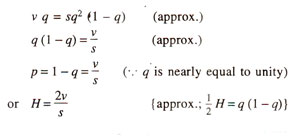Balance between mutation and selection
We have discussed above the changes in gene frequency caused either by selection alone or by mutation alone, which is, however, not the case in nature. The relative effectiveness of both the processes depends on gene frequency and if both the processes operate for long, a state of equilibrium will be reached. If we consider first a recessive gene with frequency 'q', mutation rate from dominant to recessive as 'u' and that of reverse mutation as 'v' and selection coefficient against this recessive allele as 's', then at equilibrium, we have :
If q arid s are small, this equation changes to

For a gene with no dominance,
For a gene with no dominance,
| q = |
u |
s |

where, H is the frequency of heterozygotes. If the mutant gene is rare, H is very nearly the frequency of mutant phenotype in the population.




